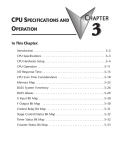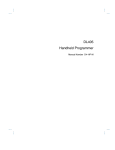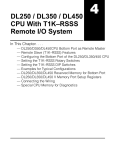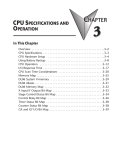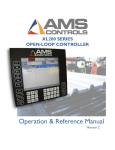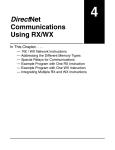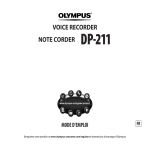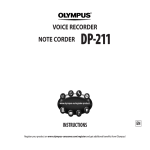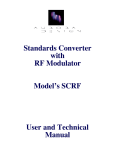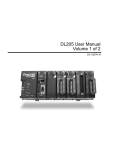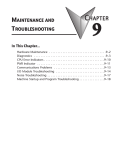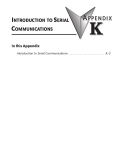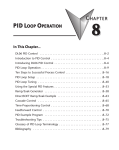Download CPU Specifications and Operations
Transcript
CPU Specifications and Operations In This Chapter. . . . — Overview — CPU General Specifications — CPU Hardware Features — Using Battery Backup — Selecting the Program Storage Media — CPU Setup — CPU Operation — I/O Response Time — CPU Scan Time Considerations — PLC Numbering Systems — Memory Map — DL350 System V-Memory — X Input / Y Output Bit Map — Control Relay Bit Map — Stage™ Control / Status Bit Map — Timer and Counter Status Bit Maps 13 3--2 CPU Specifications and Operation Overview The CPU is the heart of the control system. Almost all system operations are controlled by the CPU, so it is important that it is set-up and installed correctly. This chapter provides the information needed to understand: S the differences between the different models of CPUs S the steps required to setup and install the CPU CPU Specifications and Operation General CPU Features DL350 CPU Features The DL350 is a modular CPU which can be installed in 5, 8, or 10 slot bases. All I/O modules in the DL305 family will work with the CPU. The DL350 CPU offers a wide range of processing power and program RLL and Stage program instructions (see Chapters 5 and 7). It also provides extensive internal diagnostics that can be monitored from the application program or from an operator interface. The DL350 is different than the other CPUs in the DL305 family. It supports a 16 bit addressing format where the DL330/340 are 8 bit. This has enabled the DL350 to expanded its instruction set, memory, and features much like the DL205 and DL405 CPUs. The DL350 has a maximum of 14.8K of program memory comprised of 7.6K of ladder memory and 7.2K of V-memory (data registers). It supports a maximum of 368 points of local I/O, and 880 points with remote I/O. It includes an additional internal RISC--based microprocessor for greater processing power. The DL350 has over 150 instructions, including drum timers, a print function, floating point math, and PID loop control for 4 loops. The DL350 has a total of two communications ports. The top port is a 6 pin modular that provides a built--in RS232 communication port. It can be used for easy connection of the handheld programmer, PC, or used for a DirectNET slave. The bottom port is a 25--pin RS232C/RS422 port. It will interface with DirectSOFT, and operator interfaces, provides built--in Remote I/O, DirectNET and MODBUS RTU Master/Slave connections. DL350 User Manual, 2nd Edition CPU Specifications and Operation 3--3 CPU General Specifications Feature DL350 Total Program memory (words) 14.8K Ladder memory (words) 7680 (Flash) V-memory (words) 7168 Non-volatile V--Memory (words) No Boolean execution /K 5--6 ms RLL and RLL PLUS Programming Yes Handheld programmer DirectSOFT™ Yes programming for Windows™ Yes Yes CMOS RAM No UVPROM No EEPROM Flash Local Discrete I/O points available 368 Remote I/O points available 512 Remote I/O Channels 1 Max Number of Remote Slaves 7 Local Analog input / output channels maximum 128 / 32 Counter Interface Module (quad., pulse out, pulse catch, etc.) No I/O Module Point Density 8/16 Slots per Base 5/8/10 Number of instructions available (see Chapter 5 for details) 170 Control relays 1024 Special relays (system defined) 144 Stages in RLL PLUS 1024 Timers 256 Counters 128 Immediate I/O Yes Interrupt input (hardware / timed) No / Yes Subroutines Yes Drum Timers Yes For/Next Loops Yes Math Integer,Floating Point PID Loop Control, Built In Yes Time of Day Clock/Calendar Yes Run Time Edits Yes Supports Overrides Yes Internal diagnostics Yes Password security Yes System error log Yes User error log Yes Battery backup Yes (optional) DL350 User Manual, 2nd Edition CPU Specifications and Operation Built-in communication ports (RS232C) 3--4 CPU Specifications and Operation CPU Hardware Features Port 1 Status Indicators 6P6C Phone Jack RS232C, 9600 baud Communication Port --K-sequence --DirectNET™ slave --easily connect DirectSOFT™, handhelds, operator interfaces, any DirectNET master Port 2 25-pin D--Shell Connector RS232C/RS422, up to 38.4K baud Communication Port --K-sequence --DirectNET™ Master/Slave --MODBUS RTU Master/Slave --Built--in Remote I/O --easily connect DirectSOFT, handhelds, operator interfaces, any DirectNET or MODBUS master or slave Mode Switch Battery Slot CPU Specifications and Operation Mode Switch Functions The mode switch on the DL350 CPUs provide positions for enabling and disabling program changes in the CPU. Unless the mode switch is in the TERM position, RUN and STOP mode changes will not be allowed by any interface device, (handheld programmer, DirectSOFT programing package or operator interface). If the switch is in the TERM position and no program password is in effect, all operating modes as well as program access will be allowed through the programming or monitoring device. Mode--switch Position (Run Program) RUN TERM (Terminal) STOP (Stop Program) CPU Action CPU is forced into the RUN mode if no errors are encountered. No changes are allowed by the attached programming/monitoring device. RUN, PROGRAM and the TEST modes are available. Mode and program changes are allowed by the programming/monitoring device. CPU is forced into the STOP mode. No change or monitoring is allowed by the programming/monitoring device. There are two ways to change the CPU mode. 1. Use the CPU mode switch to select the operating mode. 2. Place the CPU mode switch in the TERM position and use a programming device to change operating modes. In this position, you can change between Run and Program modes. Status Indicators The status indicator LEDs on the CPU front panels have specific functions which can help in programming and troubleshooting. Indicator Status Meaning PWR ON Power good RUN ON CPU is in Run Mode RUN FLASHING CPU is in Firmware upgrade mode CPU ON CPU self diagnostics error BATT ON CPU battery voltage is low TX1 ON Transmitting Data from Port 1 RX1 ON Receiving Data at port 1 TX2 ON Transmitting Data from Port 2 RX2 ON Receiving Data at Port 2 DL350 User Manual, 2nd Edition CPU Specifications and Operation Port 1 Specifications The operating parameters for Port 1 on the DL350 CPU are fixed. S 6 Pin female modular (RJ12 phone jack) type connector S DirectNet (slave), K--sequence protocol S RS232C, 9600 baud S Connect to DirectSOFT, D2--HPP, DV1000 or DirectNET master 1 6 6-pin Female Modular Connector Port 2 Specifications 13 14 25 25-pin Female D Connector Port 1 Pin Descriptions (DL350 only) 1 2 3 4 5 6 0V 5V RXD TXD 5V 0V Power (--) connection (GND) Power (+) connection Receive Data (RS232C) Transmit Data (RS232C Power (+) connection Power (--) connection (GND) Port 2 on the DL350 CPU is located on the 25 pin D-shell connector. It is configurable using AUX functions on a programming device. S 25 Pin female D type connector S Protocol: K sequence, DirectNET Master/Slave, MODBUS RTU Master/Slave, Remote I/O, non--procedure S RS232C, non-isolated, distance within 15 m (approx. 50 feet) S RS422C, non-isolated, distance within 1000 m S Up to 38.4K baud S Address selectable (1--90) S Connects to DirectSOFT, operator interfaces, any DirectNETor MODBUS master or slave Port 2 Pin Descriptions (DL350 CPU) Port 2 Pin Descriptions (Cont’d) 1 2 3 4 5 6 7 8 9 10 11 12 13 14 15 16 17 18 19 20 21 22 23 24 25 not used TXD Transmit Data (RS232C) RXD Receive Data (RS232C) RTS Ready to Send (RS--232C) CTS Clear to Send (RS--232C) not used 0V Power (--) connection (GND) 0V Power (--) connection (GND) RXD + Receive Data + (RS--422) RXD -- Receive Data (RS--422) CTS + Clear to Send + (RS422) TXD + Transmit Data + (REMIO) TXD -- Transmit Data -- (REMIO) TXD + not used TXD -not used RTS -RTS + not used not used not used CTS -RXD + RXD -- Transmit Data + (RS--422 Transmit Data -- (RS--422) Request to Send -- (RS--422) Request to Send -- (RS--422) Clear to Send -- (RS--422) Receive Data + (REMIO) Receive Data -- (REMIO) DL350 User Manual, 2nd Edition CPU Specifications and Operation 1 3--5 3--6 CPU Specifications and Operation Using Battery Backup An optional lithium battery is available to maintain the system RAM retentive memory when the DL305 system is without external power. Typical CPU battery life is five years, which includes PLC runtime and normal shutdown periods. However, consider installing a fresh battery if your battery has not been changed recently and the system will be shutdown for a period of more than ten days. NOTE: Before installing or replacing your CPU battery, back-up your V-memory and system parameters. You can do this by using DirectSOFT to save the program, V-memory, and system parameters to hard/floppy disk on a personal computer. CPU Specifications and Operation To install the D2--BAT--1 CPU battery in the DL350 CPU: 1. Press the retaining clip on the battery door down and swing the battery door open. 2. Place the battery into the coin--type slot. 3. Close the battery door making sure that it locks securely in place. 4. Make a note of the date the battery was installed. DL350 WARNING: Do not attempt to recharge the battery or dispose of an old battery by fire. The battery may explode or release hazardous materials. Enabling the Battery Backup The battery can be enabled by setting bit 12 in V7633 (B7633.12) ON (see example below). In this mode the battery Low LED will come on when the battery voltage is less than 2.5VDC (SP43) and error E41 will occur. In this mode the CPU will maintain the data in C,S,T,CT, and V--memory when power is removed from the CPU, provided the battery is good. The use of a battery can also determine which operating mode is entered when the system power is connected. See CPU Setup, which is discussed later in this chapter. If you have installed a battery, the battery circuit can be disabled by turning OFF B7633.12. However, if you have a battery installed and select “No Battery” operation, the battery LED will not turn on if the battery voltage is low. SP0 LD K1000 OUT B7633.12 SP43 SP4 Y0 OUT Battery Low Lamp DL350 User Manual, 2nd Edition This rung enables the battery operation. This rung will flash Y0 if the battery gets low. CPU Specifications and Operation 3--7 CPU Setup Installing the CPU The CPU must be installed in the first slot in the base (closest to the power supply). You cannot install the CPU in any other slot. When inserting the CPU into the base, align the PC board with the grooves on the top and bottom of the base. Push the CPU straight into the base until it is firmly seated in the backplane connector. CPU must reside in first slot! WARNING: To minimize the risk of electrical shock, personal injury, or equipment damage, always disconnect the system power before installing or removing any system component. The Handheld programmer is connected to the CPU with a handheld programmer cable. You can connect the Handheld to port 1 on a DL350 CPU. The handheld programmer is shipped with a cable. The cable is approximately 6.5 feet (200 cm). Connect Handheld to Port 1 If you are using a Personal Computer with the DirectSOFT™ programming package, you can use either the top or bottom port. Connect PC to either Port DL350 User Manual, 2nd Edition CPU Specifications and Operation Connecting the Programming Devices 3--8 CPU Specifications and Operation Auxiliary Functions Many CPU setup tasks involve the use of Auxiliary (AUX) Functions. The AUX Functions perform many different operations, ranging from clearing ladder memory, displaying the scan time, copying programs to EEPROM in the handheld programmer, etc. They are divided into categories that affect different system parameters. Appendix A provides a description of the AUX functions. You can access the AUX Functions from DirectSOFT™ or from the Handheld Programmer. The manuals for those products provide step-by-step procedures for accessing the AUX Functions. Some of these AUX Functions are designed specifically for the Handheld Programmer setup, so they will not be needed (or available) with the DirectSOFT package. The following table shows a list of the Auxiliary functions for the different CPUs and the Handheld Programmer. Note, the Handheld Programmer may have additional AUX functions that are not supported with the DL305 CPUs. AUX Function and Description 350 HPP CPU Specifications and Operation AUX 2* — RLL Operations AUX Function and Description 350 HPP AUX 6* — Handheld Programmer Configuration 21 Check Program -- 22 Change Reference -- 61 Show Revision Numbers 23 Clear Ladder Range -- 62 Beeper On / Off 24 Clear All Ladders -- 65 Run Self Diagnostics AUX 3* — V-Memory Operations 31 Clear V Memory AUX 7* — EEPROM Operations -- 71 Copy CPU memory to HPP EEPROM AUX 4* — I/O Configuration 41 Show I/O Configuration -- 72 Write HPP EEPROM to CPU 42 I/O Diagnostics -- 73 44 Power-up I/O Configuration Check -- Compare CPU to HPP EEPROM 74 Blank Check (HPP EEPROM) 45 Select Configuration -- 75 Erase HPP EEPROM 76 Show EEPROM Type (CPU and HPP) AUX 5* — CPU Configuration 51 Modify Program Name -- 52 Display / Change Calendar -- 53 Display Scan Time -- 54 Initialize Scratchpad -- 55 Set Watchdog Timer -- 56 Set CPU Network Address -- 57 Set Retentive Ranges -- 58 Test Operations -- 59 Bit Override -- 5B Counter Interface Config. -- 5C Display Error History -- DL350 User Manual, 2nd Edition AUX 8* — Password Operations 81 Modify Password -- 82 Unlock CPU -- 83 Lock CPU -- supported not supported -- not applicable CPU Specifications and Operation Clearing an Existing Program Before you enter a new program, you should always clear ladder memory. You can use AUX Function 24 to clear the complete program. You can also use other AUX functions to clear other memory areas. S S S Setting the Clock and Calendar 3--9 AUX 23 — Clear Ladder Range AUX 24 — Clear all Ladders AUX 31 — Clear V-Memory The DL350 also has a Clock / Calendar that can be used for many purposes. If you need to use this feature there are also AUX functions available that allow you set the date and time. For example, you would use AUX 52, Display/Change Calendar to set the time and date with the Handheld Programmer. With DirectSOFT you would use the PLC Setup menu options using K--Sequence protocol only. The CPU uses the following format to display the date and time. S Date — Year, Month, Date, Day of week (0 -- 6, Sunday thru Saturday) S Time — 24 hour format, Hours, Minutes, Seconds Handheld Programmer Display 23:08:17 97/05/20 Initializing System Memory The DL350 CPU maintains system parameters in a memory area referred to as the “scratchpad”. In some cases, you may make changes to the system setup that will be stored in system memory. For example, if you specify a range of Control Relays (CRs) as retentive, these changes are stored. AUX 54 resets the system memory to the default values. WARNING: You may never have to use this feature unless you want to clear any setup information that is stored in system memory. Usually, you’ll only need to initialize the system memory if you are changing programs and the old program required a special system setup. You can usually change from program to program without ever initializing system memory. Remember, this AUX function will reset all system memory. If you have set special parameters such as retentive ranges, etc. they will be erased when AUX 54 is used. Make sure you that you have considered all ramifications of this operation before you select it. DL350 User Manual, 2nd Edition CPU Specifications and Operation You can use the AUX function to change any component of the date or time. However, the CPU will not automatically correct any discrepancy between the date and the day of the week. For example, if you change the date to the 15th of the month and the 15th is on a Thursday, you will also have to change the day of the week (unless the CPU already shows the date as Thursday). The day of the week can only be set using the handheld programmer. 3--10 CPU Specifications and Operation Setting the CPU Network Address The DL350 CPU has a built in DirectNET port. You can use the Handheld Programmer to set the network address for the port and the port communication parameters. The default settings are: S Station Address 1 S Hex Mode S Odd Parity S 9600 Baud The DirectNET Manual provides additional information about choosing the communication settings for network operation. Setting Retentive Memory Ranges The DL350 CPU provides certain ranges of retentive memory by default. The default ranges are suitable for many applications, but you can change them if your application requires additional retentive ranges or no retentive ranges at all. The default settings are: DL350 CPU Specifications and Operation Memory Area Default Range Avail. Range Control Relays C1000 -- C1777 C0 -- C1777 V--Memory V1400 -- V37777 V0 -- V37777 Timers None by default T0 -- T377 Counters CT0 -- CT177 CT0 -- CT177 Stages None by default S0 -- S1777 You can use AUX 57 to set the retentive ranges. You can also use DirectSOFT™ menus to select the retentive ranges. WARNING: The DL350 CPU does not come with a battery. The super capacitor will retain the values in the event of a power loss, but only for a short period of time, depending on conditions. If the retentive ranges are important for your application, make sure you obtain the optional battery. Password Protection The DL350 CPU allows you to use a password to help minimize the risk of unauthorized program and/or data changes. The DL350 offers multi--level passwords for even more security. Once you enter a password you can “lock” the CPU against access. Once the CPU is locked you must enter the password before you can use a programming device to change any system parameters. You can select an 8-digit numeric password. The CPUs are shipped from the factory with a password of 00000000. All zeros removes the password protection. If a password has been entered into the CPU you cannot enter all zeros to remove it. Once you enter the correct password, you can change the password to all zeros to remove the password protection. For more information on passwords, see Appendix A, Auxiliary Functions, Aux 8* -Password Operations. WARNING: Make sure you remember your password. If you forget your password you will not be able to access the CPU. The CPU must be returned to AutomationDirect to have the entire memory cleared in order to clear the password which is the policy of the AutomationDirect. DL350 User Manual, 2nd Edition 3--11 CPU Specifications and Operation CPU Operation Achieving the proper control for your equipment or process requires a good understanding of how DL350 CPUs control all aspects of system operation. The flow chart below shows the main tasks of the CPU operating system. In this section, we will investigate four aspects of CPU operation: S S S S At powerup, the CPU initializes the internal electronic hardware. Memory initialization starts with examining the retentive memory settings. In general, the contents of retentive memory is preserved, and non-retentive memory is initialized to zero (unless otherwise specified). After the one-time powerup tasks, the CPU begins the cyclical scan activity. The flowchart to the right shows how the tasks differ, based on the CPU mode and the existence of any errors. The “scan time” is defined as the average time around the task loop. Note that the CPU is always reading the inputs, even during program mode. This allows programming tools to monitor input status at any time. The outputs are only updated in Run mode. In program mode, they are in the off state. In Run Mode, the CPU executes the user ladder program. Immediately afterwards, any PID loops which are configured are executed (DL350 only). Then the CPU writes the output results of these two tasks to the appropriate output points. Error detection has two levels. Non-fatal errors are reported, but the CPU remains in its current mode. If a fatal error occurs, the CPU is forced into program mode and the outputs go off. Power up Initialize hardware Check I/O module config. and verify Initialize various memory based on retentive configuration Update input Read input data from Specialty and Remote I/O Service peripheral CPU Specifications and Operation CPU Operating System CPU Operating System — the CPU manages all aspects of system control. CPU Operating Modes — The three primary modes of operation are Program Mode, Run Mode, and Test Mode. CPU Timing — The two important areas we discuss are the I/O response time and the CPU scan time. CPU Memory Map — The CPUs memory map shows the CPU addresses of various system resources, such as timers, counters, inputs, and outputs. CPU Bus Communication Update Clock / Calendar PGM Mode? RUN Execute ladder program PID Operations (DL350) Update output Write output data to Specialty and Remote I/O Do diagnostics OK OK? YES NO Report the error, set flag, register, turn on LED Fatal error YES Force CPU into PGM mode DL350 User Manual, 2nd Edition NO 3--12 CPU Specifications and Operation Program Mode Operation In Program Mode the CPU does not execute the application program or update the output modules. The primary use for Program Mode is to enter or change an application program. You also use the program mode to set up CPU parameters, such as the network address, retentive memory areas, etc. Download Program You can use the mode switch on the DL350 CPU to select Program Mode operation. Or, with the switch in TERM position, you can use a programming device such as the Handheld Programmer to place the CPU in Program Mode. CPU Specifications and Operation Run Mode Operation In Run Mode, the CPU executes the application program, does PID calculations for configured PID loops (DL350 only), and updates the I/O system. You can perform many operations during Run Mode. Some of these include: S Monitor and change I/O point status S Update timer/counter preset values S Update Variable memory locations Read Inputs Read Inputs from Specialty I/O Service Peripherals, Force I/O CPU Bus Communication Update Clock, Special Relays Run Mode operation can be divided into several key areas. It is very important you understand how each of these areas of execution can affect the results of your application program solutions. You can use the mode switch to select Run Mode operation. Or, with the mode switch in TERM position, you can use a programming device, such as the Handheld Programmer to place the CPU in Run Mode. Solve the Application Program Solve PID Equations (DL350) Write Outputs Write Outputs to Specialty I/O Diagnostics You can also edit the program during Run Mode. The Run Mode Edits are not “bumpless”. Instead, the CPU maintains the outputs in their last state while it accepts the new program information. If an error is found in the new program, then the CPU will turn all the outputs off and enter the Program Mode. WARNING: Only authorized personnel fully familiar with all aspects of the application should make changes to the program. Changes during Run Mode become effective immediately. Make sure you thoroughly consider the impact of any changes to minimize the risk of personal injury or damage to equipment. DL350 User Manual, 2nd Edition CPU Specifications and Operation 3--13 Read Inputs The CPU reads the status of all inputs, then stores it in the image register. Input image register locations are designated with an X followed by a memory location. Image register data is used by the CPU when it solves the application program. Of course, an input may change after the CPU has read the inputs. Generally, the CPU scan time is measured in milliseconds. If you have an application that cannot wait until the next I/O update, you can use Immediate Instructions. These do not use the status of the input image register to solve the application program. The Immediate instructions immediately read the input status directly from I/O modules. However, this lengthens the program scan since the CPU has to read the I/O point status again. A complete list of the Immediate instructions is included in Chapter 5. Read Inputs from Specialty and Remote I/O After the CPU reads the inputs from the input modules, it reads any input point data from any Specialty modules that are installed. This is also the portion of the scan that reads the input status from Remote I/O racks. DL205 DL305 RSSS _ _ _ Service Peripherals After the CPU reads the inputs from the input modules, it reads any attached peripheral devices. This is primarily a communications service for any attached and Force I/O devices. For example, it would read a programming device to see if any input, output, or other memory type status needs to be modified. S Forcing from a peripheral -- not a permanent force, good only for one scan Regular Forcing — This type of forcing can temporarily change the status of a discrete bit. For example, you may want to force an input on, even though it is really off. This allows you to change the point status that was stored in the image register. This value will be valid until the image register location is written to during the next scan. This is primarily useful during testing situations when you need to force a bit on to trigger another event. Update Clock, The DL350 CPUs has an internal real-time clock and calendar timer which is accessible to the application program. Special V-memory locations hold this Special Relays, information. This portion of the execution cycle makes sure these locations get and Special updated on every scan. Also, there are several different Special Relays, such as Registers diagnostic relays, etc., that are also updated during this segment. DL350 User Manual, 2nd Edition CPU Specifications and Operation NOTE: It may appear the Remote I/O point status is updated every scan. This is not quite true. The CPU will receive information from the Remote I/O Master module every scan, but the Remote Master may not have received an update from all the Remote slaves. Remember, the Remote I/O link is managed by the Remote Master, not the CPU. 3--14 CPU Specifications and Operation Solve Application Program The CPU evaluates each instruction in the application program during this segment of the scan cycle. The instructions define the relationship between input conditions and the system outputs. The CPU begins with the first rung of the ladder program, evaluating it from left to right and from top to bottom. It continues, rung by rung, until it encounters the END coil instruction. At that point, a new image for the outputs is complete. X0 X1 Y0 OUT C0 CPU Specifications and Operation Read Inputs from Specialty I/O Service Peripherals, Force I/O CPU Bus Communication Update Clock, Special Relays Solve the Application Program Solve PID equations (DL350) C100 X5 Read Inputs LD X10 K10 Write Outputs Y3 OUT Write Outputs to Specialty I/O END Diagnostics The internal control relays (C), the stages (S), and the variable memory (V) are also updated in this segment. You may recall the CPU may have obtained and stored forcing information when it serviced the peripheral devices. If any I/O points or memory data have been forced, the output image register also contains this information. NOTE: If an output point was used in the application program, the results of the program solution will overwrite any forcing information that was stored. For example, if Y0 was forced on by the programming device, and a rung containing Y0 was evaluated such that Y0 should be turned off, then the output image register will show that Y0 should be off. Of course, you can force output points that are not used in the application program. In this case, the point remains forced because there is no solution that results from the application program execution. Solve PID Loop Equations The DL350 CPU can process up to 4 PID loops. The loop calculations are run as a separate task from the ladder program execution, immediately following it. Only loops which have been configured are calculated, and then only according to a built-in loop scheduler. The sample time (calculation interval) of each loop is programmable. Please refer to Chapter 8, PID Loop Operation, for more on the effects of PID loop calculation on the overall CPU scan time. Write Outputs Once the application program has solved the instruction logic and constructed the output image register, the CPU writes the contents of the output image register to the corresponding output points located in the local CPU base or the local expansion bases. Remember, the CPU also made sure any forcing operation changes were stored in the output image register, so the forced points get updated with the status specified earlier. DL350 User Manual, 2nd Edition CPU Specifications and Operation Write Outputs to Specialty and Remote I/O 3--15 After the CPU updates the outputs in the local and expansion bases, it sends the output point information that is required by any Specialty modules which are installed. For example, this is the portion of the scan that writes the output status from the image register to the Remote I/O racks. NOTE: It may appear the Remote I/O point status is updated every scan. This is not quite true. The CPU will send the information to the Remote I/O Master module every scan, but the Remote Master will update the actual remote modules during the next communication sequence between the master and slave modules. Remember, the Remote I/O link communication is managed by the Remote Master, not the CPU. Diagnostics Read Inputs Read Inputs from Specialty I/O Service Peripherals, Force I/O CPU Bus Communication Update Clock, Special Relays Solve the Application Program Solve PID Loop Equations Write Outputs Write Outputs to Specialty I/O Diagnostics You can use AUX 53 to view the minimum, maximum, and current scan time. Use AUX 55 to increase or decrease the watchdog timer value. There is also an RSTWT instruction that can be used in the application program to reset the watch dog timer during the CPU scan. DL350 User Manual, 2nd Edition CPU Specifications and Operation During this part of the scan, the CPU performs all system diagnostics and other tasks, such as: S calculating the scan time S updating special relays S resetting the watchdog timer The DL350 CPU automatically detects and reports many different error conditions. Appendix B contains a listing of the various error codes available with the DL305 system. One of the more important diagnostic tasks is the scan time calculation and watchdog timer control. The DL350 CPU has a “watchdog” timer that stores the maximum time allowed for the CPU to complete the solve application segment of the scan cycle. The default value set from the factory is 200 mS. If this time is exceeded the CPU will enter the Program Mode, turn off all outputs, and report the error. For example, the Handheld Programmer displays “E003 S/W TIMEOUT” when the scan overrun occurs. 3--16 CPU Specifications and Operation I/O Response Time Is Timing Important I/O response time is the amount of time required for the control system to sense a change in an input point and update a corresponding output point. In the majority of for Your applications, the CPU performs this task practically instantaneously. However, Application? some applications do require extremely fast update times. There are four things that can affect the I/O response time: Normal Minimum I/O Response S The point in the scan period when the field input changes states S Input module Off to On delay time S CPU scan time S Output module Off to On delay time The I/O response time is shortest when the module senses the input change before the Read Inputs portion of the execution cycle. In this case the input status is read, the application program is solved, and the output point gets updated. The following diagram shows an example of the timing for this situation. CPU Specifications and Operation Scan Scan Solve Program Solve Program Read Inputs Solve Program Solve Program Write Outputs Field Input Input Module Off/On Delay CPU Reads Inputs CPU Writes Outputs Output Module Off/On Delay I/O Response Time In this case, you can calculate the response time by simply adding the following items. Input Delay + Scan Time + Output Delay = Response Time Normal Maximum I/O Response The I/O response time is longest when the module senses the input change after the Read Inputs portion of the execution cycle. In this case the new input status does not get read until the following scan. The following diagram shows an example of the timing for this situation. In this case, you can calculate the response time by simply adding the following items. Input Delay +(2 x Scan Time) + Output Delay = Response Time DL350 User Manual, 2nd Edition CPU Specifications and Operation 3--17 Scan Scan Solve Program Solve Program Read Inputs Solve Program Solve Program Write Outputs Field Input CPU Reads Inputs Input Module Off/On Delay CPU Writes Outputs Output Module Off/On Delay I/O Response Time Improving Response Time Scan Scan Solve Program Solve Program Normal Read Input Read Input Immediate Solve Program Write Output Immediate Solve Program Normal Write Outputs Field Input Input Module Off/On Delay Output Module Off/On Delay I/O Response Time In this case, you can calculate the response time by simply adding the following items. Input Delay + Instruction Execution Time + Output Delay = Response Time The instruction execution time is calculated by adding the time for the immediate input instruction, the immediate output instruction, and all instructions in between. NOTE: When the immediate instruction reads the current status from a module, it uses the results to solve that one instruction without updating the image register. Therefore, any regular instructions that follow will still use image register values. Any immediate instructions that follow will access the module again to update the status. DL350 User Manual, 2nd Edition CPU Specifications and Operation There are a few things you can do the help improve throughput. S Choose instructions with faster execution times S Use immediate I/O instructions (which update the I/O points during the ladder program execution segment) S Choose modules that have faster response times Immediate I/O instructions are probably the most useful technique. The following example shows immediate input and output instructions, and their effect. 3--18 CPU Specifications and Operation CPU Specifications and Operation CPU Scan Time Considerations The scan time covers all the cyclical tasks that are performed by the operating system. You can use DirectSOFT or the Handheld Programmer to display the minimum, maximum, and current scan times that have occurred since the previous Program Mode to Run Mode transition. This information can be very important when evaluating the performance of a system. As shown previously, there are several segments that make up the scan cycle. Each of these segments requires a certain amount of time to complete. Of all the segments, the only one you really have the most control over is the amount of time it takes to execute the application program. This is because different instructions take different amounts of time to execute. So, if you think you need a faster scan, then you can try to choose faster instructions. Your choice of I/O modules and system configuration, such as expansion or remote I/O, can also affect the scan time. However, these things are usually dictated by the application. For example, if you have a need to count pulses at high rates of speed, then you’ll probably have to use a High-Speed Counter module. Also, if you have I/O points that need to be located several hundred feet from the CPU, then you need remote I/O because it’s much faster and cheaper to install a single remote I/O cable than it is to run all those signal wires for each individual I/O point. The following paragraphs provide some general information on how much time some of the segments can require. Power up Initialize hardware Check I/O module config. and verify Initialize various memory based on retentive configuration Update input Read input data from Specialty and Remote I/O Service peripheral CPU Bus Communication Update Clock / Calendar PGM Mode? RUN Execute ladder program PID Equations (DL350) Update output Write output data to Specialty and Remote I/O Do diagnostics OK OK? NO Report the error, set flag, register, turn on LED Fatal error YES Force CPU into PGM mode DL350 User Manual, 2nd Edition YES NO CPU Specifications and Operation Intialization Process 3--19 Communication requests can occur at any time during the scan, but the CPU only “logs” the requests for service until the Service Peripherals portion of the scan. The CPU does not spend any time on this if there are no peripherals connected. To Service Request DL350 Minimum 1.2 μs Maximum 1.5-- μs Service Peripherals Communication requests can occur at any time during the scan, but the CPU only “logs” the requests for service until the Service Peripherals portion of the scan. The CPU does not spend any time on this if there are no peripherals connected. To Log Request (anytime) Nothing Connected Port 1 Port 2 Min. & Max. 0 μs Send Min. / Max. 6.8/12.6 μs Rec. Min. / Max. 9.2/972 ms Send Min. / Max. 6.8/12.6 μs Rec. Min. / Max. 9.2/972 ms Some specialty modules can also communicate directly with the CPU via the CPU bus. During this portion of the cycle the CPU completes any CPU bus communications. The actual time required depends on the type of modules installed and the type of request being processed. NOTE: Some specialty modules can have a considerable impact on the CPU scan time. If timing is critical in your application, consult the module documentation for any information concerning the impact on the scan time. Update Clock / Calendar, Special Relays, Special Registers The clock, calendar, and special relays are updated and loaded into special V-memory locations during this time. This update is performed during both Run and Program Modes. Modes Program Mode Run Mode Diagnostics DL350 Minimum 79.0 μs Maximum 79.0 μs Minimum 79.0 μs Maximum 79.0 μs The DL305 CPUs perform many types of system diagnostics. The amount of time required depends on many things, such as the number of I/O modules installed, etc. The following table shows the minimum and maximum times that can be expected. Diagnostic Time DL350 Minimum 104.0 μs Maximum 139.6 μs DL350 User Manual, 2nd Edition CPU Specifications and Operation CPU Bus Communication DL350 3--20 CPU Specifications and Operation CPU Specifications and Operation The CPU processes the program from the Application Program Execution top (address 0) to the END instruction. The CPU executes the program left to right and top to bottom. As each rung is evaluated the appropriate image register or memory location is updated. The time required to solve the application program depends on the type and number of instructions used, and the amount of execution overhead. You can add the execution times for all the instructions in your program to find the total program execution time. For example, the execution time for a DL350 running the program shown would be calculated as follows. Instruction Time STR X0 OR C0 ANDN X1 OUT Y0 STRN C100 LD K10 STRN C101 OUT V2002 STRN C102 LD K50 STRN C103 OUT V2006 STR X5 ANDN X10 OUT Y3 END 1.4μs 1.0μs 1.2μs 7.95μs 1.6μs 62μs 1.6μs 21.0μs 1.6μs 62μs 1.6μs 21.0μs 1.4μs 1.2μs 7.95μs 16μs TOTAL X0 X1 Y0 OUT C0 C100 LD C101 OUT V2002 C102 LD C103 X5 K10 K50 OUT V2006 X10 Y3 OUT END 210.5μs Appendix C provides a complete list of instruction execution times for the DL350 CPU. Program Control Instructions — the DL350 CPU offers additional instructions that can change the way the program executes. These instructions include FOR/NEXT loops, Subroutines, and Interrupt Routines. These instructions can interrupt the normal program flow and effect the program execution time. Chapter 5 provides detailed information on how these different types of instructions operate. DL350 User Manual, 2nd Edition 3--21 CPU Specifications and Operation PLC Numbering Systems If you are a new PLC user or are using octal 49.832 binary AutomationDirect PLCs for the first time, ? 1482 BCD please take a moment to study how our ? 0402 ? ? 3 PLCs use numbers. You will find that each 3A9 ASCII PLC manufacturer has their own 7 conventions on the use of numbers in their hexadecimal PLCs. Take a moment to familiarize 1001011011 1011 --961428 yourself with how numbers are used in ? decimal AutomationDirect PLCs. The A 72B information you learn here applies to all ? 177 --300124 our PLCs! ? Octal means simply counting in groups of eight things at a time. In the figure to the right, there are eight circles. The quantity in decimal is “8”, but in octal it is “10” (8 and 9 are not valid in octal). In octal, “10” means 1 group of 8 plus 0 (no individuals). Decimal 1 2 3 4 5 6 7 8 Octal 1 2 3 4 5 6 7 10 In the figure below, ther are two groups of eight circles. Counting in octal ther are “20” items, meaning 2 groups of eight, plus 0 individuals Avoid saying “twenty”, say “two--zero octal”. This makes a clear distinction between number systems. Decimal 1 2 3 4 5 6 7 8 9 10 11 12 13 14 15 16 Octal 5 6 7 10 11 12 13 14 15 16 17 20 1 2 3 4 After counting PLC resources, it’s time to access PLC resources (there is a difference). The CPU instruction set accesses resources of the PLC using octal addresses. Octal addresses are the same as octal quantities, except they start counting at zero. The number zero is significant to a computer, so we don’t skip it. The circles are in an array of square containers to the right. To access a resource, the PLC instruction will address its location using the octal references shown. If these were counters, “CT14” would access the black circle location. X= 0 1 2 3 4 X 1X 2X DL350 User Manual, 2nd Edition 5 6 7 CPU Specifications and Operation PLC Resources PLCs store and manipulate numbers in binary form: ones and zeros. So why do we have numbers in so many different forms? Numbers have meaning, and some representations are more convenient than others for particular purposes. Sometimes we use numbers to represent a size or amount of something. Other numbers refer to locations or addresses, or to time. In science we attach engineering units to numbers to give a particular meaning (see Appendix I for numbering system details). PLCs offer a fixed amount of resources, depending on the model and configuration. The word “resources” includes variable memory (V-memory), I/O points, timers, counters, etc. Most modular PLCs allow you to add I/O points in groups of eight. In fact, all the resources of our PLCs are counted in octal. It’s easier for computers to count in groups of eight than ten, because eight is an even power of 2. 3--22 CPU Specifications and Operation V--Memory Variable memory (called “V-memory”) stores data for the ladder program and for configuration settings. V-memory locations and V-memory addresses are the same thing, and are numbered in octal. For example, V2073 is a valid location, while V1983 is not valid (“9” and “8” are not valid octal digits). Each V-memory location is one data word wide, meaning 16 bits. For configuration registers, our manuals will show each bit of a V-memory word. The least significant bit (LSB) will be on the right, and the most significant bit (MSB) on the left. The word “significant”, refers to the relative binary weighting of the bits. V-memory address (octal) MSB CPU Specifications and Operation LSB 0 1 0 0 1 1 1 0 0 0 1 0 1 0 0 1 V2017 Binary-Coded Decimal Numbers V-memory data (binary) V-memory data is 16-bit binary, but the data registers are rarely programmmed one bit at a time. Instructions or viewing tools work with binary, decimal, octal, and hexadecimal numbers. All of these are converted and stored as binary for us. A frequently-asked question is “How do I tell if a number is binary, octal, BCD, or hex”? The answer is that we usually cannot tell by looking at the data... but it does not really matter. What matters is: the source or mechanism which writes data into a V-memory location and the thing which later reads it must both use the same data type (i.e., octal, hex, binary, or whatever). The V-memory location is a storage box... that’s all. It does not convert or move the data on its own. Since humans naturally count in decimal, we prefer to enter and view PLC data in decimal as well (via operator interfaces). However, computers are more efficient in using pure binary numbers. A compromise solution between the two is Binary-Coded Decimal (BCD) representation. A BCD digit ranges from 0 to 9, and is stored as four binary bits (a nibble). This permits each V-memory location to store four BCD digits, with a range of decimal numbers from 0000 to 9999. 4 BCD number 8 V-memory storage 4 9 2 1 0 1 0 0 8 4 3 2 1 1 0 0 1 8 4 6 2 1 0 0 1 1 8 4 2 1 0 1 1 0 In a pure binary sense, a 16-bit word represents numbers from 0 to 65535. In storing BCD numbers, the range is reduced to 0 to 9999. Many math instructions use BCD data, and DirectSOFT and the handheld programmer allow us to enter and view data in BCD. Special RLL instructions convert from BCD to binary, or visa--versa. Hexadecimal Numbers Hexadecimal numbers are similar to BCD numbers, except they utilize all possible binary values in each 4-bit digit. They are base-16 numbers so we need 16 different digits. To extend our decimal digits 0 through 9, we use A through F as shown. Decimal Hexadecimal 0 1 2 3 0 1 2 3 4 5 4 5 6 6 7 7 8 9 10 11 12 13 14 15 8 9 A B C D E F A 4-digit hexadecimal number can represent all 65536 values in a V-memory word. The range is from 0000 to FFFF (hex). PLCs often need this full range for sensor data, etc. Hexadecimal is a convenient way for humans to view full binary data. Hexadecimal number V-memory storage DL350 User Manual, 2nd Edition A 7 F 4 1 0 1 0 0 1 1 1 1 1 1 1 0 1 0 0 3--23 CPU Specifications and Operation Memory Map With any PLC system, you generally have many different types of information to process. This includes input device status, output device status, various timing elements, parts counts, etc. It is important to understand how the system represents and stores the various types of data. For example, you need to know how the system identifies input points, output points, data words, etc. The following paragraphs discuss the various memory types used in the DL350 CPU. A memory map overview follows the memory descriptions. Octal Numbering System All memory locations or areas are numbered in Octal (base 8). For example, the diagram shows how the octal numbering system works for the discrete input points. Notice the octal system does not contain any numbers with the digits 8 or 9. X0 Y40 X20 X0 Y57 X37 X17 X1 X2 X3 X4 X5 X6 X7 Discrete and Word Locations V--Memory Locations for Discrete Memory Areas As you examine the different memory types, you’ll notice two types of memory in the DL350, discrete and word memory. Discrete memory is one bit that can be either a 1 or a 0. Word memory is referred to as V--memory (variable) and is a 16-bit location normally used to manipulate data/numbers, store data/numbers, etc. Some information is automatically stored in V--memory. For example, the timer current values are stored in V--memory. Discrete -- On or Off, 1 bit X0 Word Locations -- 16 bits 0 1 0 1 00 0 0 0 0 1 0 0 1 0 1 The discrete memory area is for inputs, outputs, control relays, special relays, stages, timer status bits and counter status bits. However, you can also access the bit data types as a V-memory word. Each V-memory location contains 16 consecutive discrete locations. For example, the following diagram shows how the X input points are mapped into V-memory locations. 16 Discrete (X) Input Points X17 X16 X15 X14 X13 X12 X11 X10 Bit # 15 14 13 12 11 10 9 8 X7 X6 X5 X4 X3 X2 X1 X0 7 6 5 4 3 2 1 0 V40400 These discrete memory areas and their corresponding V memory ranges are listed in the memory area table for the DL350 CPU in this chapter. DL350 User Manual, 2nd Edition CPU Specifications and Operation X10 X11 X12 X13 X14 X15 X16 X17 3--24 CPU Specifications and Operation Input Points (X Data Type) Output Points (Y Data Type) CPU Specifications and Operation Control Relays (C Data Type) Timers and Timer Status Bits (T Data type) The discrete input points are noted by an X data type. There are up to 512 discrete input points available with the DL350 CPU. In this example, the output point Y0 will be turned on when input X0 energizes. The discrete output points are noted by a Y data type. There are up to 512 discrete output points available with the DL350 CPU. In this example, output point Y1 will turn on when input X1 energizes. Control relays are discrete bits normally used to control the user program. The control relays do not represent a real world device, that is, they cannot be physically tied to switches, output coils, etc. They are internal to the CPU. Control relays can be programmed as discrete inputs or discrete outputs. These locations are used in programming the discrete memory locations (C) or the corresponding word location which has 16 consecutive discrete locations. In this example, memory location C5 will energize when input X10 turns on. The second rung shows a simple example of how to use a control relay as an input. The amount of timers available depends on the model of CPU you are using. The tables at the end of this section provide the number of timers for the DL350. Regardless of the number of timers, you have access to timer status bits that reflect the relationship between the current value and the preset value of a specified timer. The timer status bit will be on when the current value is equal or greater than the preset value of a corresponding timer. When input X0 turns on, timer T1 will start. When the timer reaches the preset of 3 seconds (K of 30) timer status contact T1 turns on. When T1 turns on, output Y12 turns on. DL350 User Manual, 2nd Edition X0 Y0 OUT X1 Y1 OUT X10 C5 OUT C5 Y10 OUT Y20 OUT X0 T1 TMR K30 T1 Y12 OUT 3--25 CPU Specifications and Operation Timer Current Values (V Data Type) Counters and Counter Status Bits (CT Data type) The amount of counters available depends on the model of CPU you are using. The tables at the end of this section provide the number of counters for the DL350. Regardless of the number of counters, you have access to counter status bits that reflect the relationship between the current value and the preset value of a specified counter. The counter status bit will be on when the current value is equal to or greater than the preset value of a corresponding counter. Each time contact X0 transitions from off to on, the counter increments by one. If X1 comes on, the counter is reset to zero. When the counter reaches the preset of 10 counts (K of 10) counter status contact CT3 turns on. When CT3 turns on, output Y12 turns on. Like the timers, the counter current values are also automatically stored in V--memory. For example, V1000 holds the current value for Counter CT0, V1001 holds the current value for Counter CT1, etc. The primary reason for this is programming flexibility. The example shows how you can use relational contacts to monitor the counter values. X0 TMR T1 K1000 V1 K30 Y12 OUT V1 K50 Y13 OUT V1 K75 V1 X0 K100 CNT K10 Y14 OUT CT3 X1 CT3 Y12 OUT X0 CNT K10 CT3 X1 V1003 K1 Y12 OUT V1003 K3 Y13 OUT V1003 K5 V1003 K8 DL350 User Manual, 2nd Edition Y14 OUT CPU Specifications and Operation Counter Current Values (V Data Type) As mentioned earlier, some information is automatically stored in V--memory. This is true for the current values associated with timers. For example, V0 holds the current value for Timer 0, V1 holds the current value for Timer 1, etc. The primary reason for this is programming flexibility. The example shows how you can use relational contacts to monitor several time intervals from a single timer. 3--26 CPU Specifications and Operation Word Memory (V Data Type) Word memory is referred to as V--memory (variable) and is a 16-bit location normally used to manipulate data/numbers, store data/numbers, etc. Some information is automatically stored in V--memory. For example, the timer current values are stored in V--memory. The example shows how a four-digit BCD constant is loaded into the accumulator and then stored in a V-memory location. X0 LD OUT CPU Specifications and Operation Special Relays (SP Data Type) Stages are used in RLL PLUS programs to create a structured program, similar to a flowchart. Each program Stage denotes a program segment. When the program segment, or Stage, is active, the logic within that segment is executed. If the Stage is off, or inactive, the logic is not executed and the CPU skips to the next active Stage. See Chapter 7 for a more detailed description of RLL PLUS programming. Each Stage also has a discrete status bit that can be used as an input to indicate whether the Stage is active or inactive. If the Stage is active, then the status bit is on. If the Stage is inactive, then the status bit is off. This status bit can also be turned on or off by other instructions, such as the SET or RESET instructions. This allows you to easily control stages throughout the program. Special relays are discrete memory locations with pre-defined functionality. There are many different types of special relays. For example, some aid in program development, others provide system operating status information, etc. Appendix D provides a complete listing of the special relays. In this example, control relay C10 will energize for 50 ms and de-energize for 50 ms because SP5 is a pre--defined relay that will be on for 50 ms and off for 50 ms. DL350 User Manual, 2nd Edition V2000 Word Locations -- 16 bits 1 Stages (S Data type) K1345 3 4 5 Ladder Representation ISG S0000 Wait forStart Start X0 S1 JMP S500 JMP SG S0001 Check for a Part Part Present X1 S2 JMP Part Present X1 SG S0002 S6 JMP Clamp the part Clamp SET S400 S3 JMP Part Locked X2 SP5 C10 OUT SP4: 1 second clock SP5: 100 ms clock SP6: 50 ms clock CPU Specifications and Operation 3--27 DL350 System V-memory System V-memory V7620--V7627 Description of Contents Default Values / Ranges Locations for DV--1000 operator interface parameters V7620 Sets the V-memory location that contains the value. V0 -- V3777 V7621 Sets the V-memory location that contains the message. V0 -- V3777 V7622 Sets the total number (1 -- 16) of V-memory locations to be displayed. 1 -- 16 V7623 Sets the V-memory location that contains the numbers to be displayed. V0 -- V3777 V7624 Sets the V-memory location that contains the character code to be displayed. V0 -- V3777 V7625 Contains the function number that can be assigned to each key. V-memory for X, Y, or C V7626 Reserved 0,1,2,3,12 V7627 Reserved Default=0000 Reserved -- V7633 User defined timer interrupt/operation of battery/Binary instruction sign flag* Bit 0--7 40H Setting Interrupt Bit 12 ON with battery sign flag. ON use sign flag -OFF no sign flag Bit 15 Binary instruction sign flag. ON use sign flag -OFF no sign flag V7634 User defined timer interrupt V7640 Loop Table Beginning address V1400--V7340 V7641 Number of Loops Enabled 1--4 V7642 Error Code -- V--memory Error Location for Loop Table V7643--V7647 Reserved V7650 Port 2 End--code setting Setting (A55A), Nonprocedure communications start. V7651 Port 2 Data format --Non--procedure communications format setting. V7652 Port 2 Format Type setting -- Non--procedure communications type code setting. V7653 Port 2 Terminate--code setting -- Non--procedure communications Termination code setting. V7654 Port 2 Store V--mem address -- Non--procedure communication data store V--Memory address. V7655 Port 2 Setup area --0--7 Comm protocol (flag 0) 8--15 Comm time out/response delay time (flag 1) V7656 Port 2 setup area -- 0--15 Communication (flag2, flag 3) V7657 Port 2 setup area -- Bit to select use of parameter V7660--V7707 Set--up Information V7710--V7717 Reserved V7720--V7722 Locations for DV--1000 operator interface parameters. V7720 Titled Timer preset value pointer V7721 Title Counter preset value pointer V7722 HiByte-Titled Timer preset block size, LoByte-Titled Counter preset block size V7730--V7737 For slot 0 to 7 D3--DCM V7747 Location contains a 10ms counter. This location increments once every 10ms. V7750 Reserved DL350 User Manual, 2nd Edition CPU Specifications and Operation V7630--V7632 3--28 CPU Specifications and Operation CPU Specifications and Operation System V-memory Description of Contents V7751 Fault Message Error Code — stores the 4-digit code used with the FAULT instruction when the instruction is executed. V7752 Reserved V7753 Reserved V7754 Reserved V7755 Error code — stores the fatal error code. V7756 Error code — stores the major error code. V7757 Error code — stores the minor error code. V7760--V7762 Reserved V7763--V7764 Location for syntax error information. V7765 Scan — stores the total number of scan cycles that have occurred since the last Program Mode to Run Mode transition. V7766 Contains the number of seconds on the clock. (00 to 59). V7767 Contains the number of minutes on the clock. (00 to 59). V7770 Contains the number of hours on the clock. (00 to 23). V7771 Contains the day of the week. (Mon, Tue, etc.). V7772 Contains the day of the month (1st, 2nd, etc.). V7773 Contains the month. (01 to 12) V7774 Contains the year. (00 to 99) V7775 Scan — stores the current scan time (milliseconds). V7776 Scan — stores the minimum scan time that has occurred since the last Program Mode to Run Mode transition (milliseconds). V7777 Scan — stores the maximum scan time that has occurred since the last Program Mode to Run Mode transition (milliseconds). The following system control relays are valid only for D3--350 CPU remote I/O setup on Communications Port 2. System CRs Description of Contents C740 Completion of setups -- ladder logic must turn this relay on when it has finished writing to the Remote I/O setup table C741 Erase received data -- turning on this flag will erase the received data during a communication error. C743 Re-start -- Turning on this relay will resume after a communications hang-up on an error. C750 to C757 Setup Error -- The corresponding relay will be ON if the setup table contains an error (C750 = master, C751 = slave 1... C757=slave 7 C760 to C767 Communications Ready -- The corresponding relay will be ON if the setup table data is valid (C760 = master, C761 = slave 1... C767=slave 7 DL350 User Manual, 2nd Edition CPU Specifications and Operation 3--29 DL350 Memory Map Memory Type Discrete Memory Reference (octal) Word Memory Reference (octal) Qty. Decimal Symbol Input Points X0 -- X777 V40400 -- V40437 512 X0 Output Points Y0 -- Y777 V40500 -- V40537 512 Y0 Control Relays C0 -- C1777 V40600 -- V40677 1024 Special Relays SP0 -- SP777 V41200 -- V41237 512 Timer Current Values None V0 -- V377 256 Timer Status Bits T0 -- T377 V41100 -- V41117 256 Counter Current Values None V1000 -- V1177 128 Counter Status Bits CT0 -- CT177 V41140 -- V41147 128 Data Words none V1400 -- V7377 V10000--V17777 3072 4096 Stages S0 -- S1777 V41000 -- V41077 1024 None V7400--V7777 256 C0 SP0 V0 K100 CPU Specifications and Operation System parameters C0 T0 V1000 K100 CT0 None specific, used with many instructions SG S0 S 001 System specific, used for various purposes DL350 User Manual, 2nd Edition 3--30 CPU Specifications and Operation DL350 Aliases An alias is an alternate way of referring to certain memory types, such as timer/counter current values, V--memory locations for I/O points, etc., which simplifies understanding the memory address. The use of the alias is optional, but some users may find the alias to be helpful when developing a program. The table below shows how the aliases can be used to reference memory locations. Address Start Alias Start V0 TA0 V1000 CTA0 V1000 is the counter accumulator value for counter 0, therefore, it’s alias is CTA0. CTA1 is the alias for V1001, etc. VGX V40000 is the word memory reference for discrete bits GX0 through GX17, therefore, it’s alias is VGX0. V40001 is the word memory reference for discrete bits GX20 through GX 37, therefore, it’s alias is VGX20. VGY V40200 is the word memory reference for discrete bits GY0 through GY17, therefore, it’s alias is VGY0. V40201 is the word memory reference for discrete bits GY20 through GY 37, therefore, it’s alias is VGY20. VX0 V40400 is the word memory reference for discrete bits X0 through X17, therefore, it’s alias is VX0. V40401 is the word memory reference for discrete bits X20 through X37, therefore, it’s alias is VX20. VY0 V40500 is the word memory reference for discrete bits Y0 through Y17, therefore, it’s alias is VY0. V40501 is the word memory reference for discrete bits Y20 through Y37, therefore, it’s alias is VY20. VC0 V40600 is the word memory reference for discrete bits C0 through C17, therefore, it’s alias is VC0. V40601 is the word memory reference for discrete bits C20 through C37, therefore, it’s alias is VC20. VS0 V41000 is the word memory reference for discrete bits S0 through S17, therefore, it’s alias is VS0. V41001 is the word memory reference for discrete bits S20 through S37, therefore, it’s alias is VS20. VT0 V41100 is the word memory reference for discrete bits T0 through T17, therefore, it’s alias is VT0. V41101 is the word memory reference for discrete bits T20 through T37, therefore, it’s alias is VT20. VCT0 V41140 is the word memory reference for discrete bits CT0 through CT17, therefore, it’s alias is VCT0. V41141 is the word memory reference for discrete bits CT20 through CT37, therefore, it’s alias is VCT20. VSP0 V41200 is the word memory reference for discrete bits SP0 through SP17, therefore, it’s alias is VSP0. V41201 is the word memory reference for discrete bits SP20 through SP37, therefore, it’s alias is VSP20. V40000 CPU Specifications and Operation V40200 V40400 V40500 V40600 V41000 V41100 V41140 V41200 DL350 User Manual, 2nd Edition Example V0 is the timer accumulator value for timer 0, therefore, it’s alias is TA0. TA1 is the alias for V1, etc.. CPU Specifications and Operation 3--31 X Input / Y Output Bit Map This table provides a listing of the individual Input points associated with each V-memory address bit. MSB DL350 Input (X) and Output (Y) Points LSB 14 13 12 11 10 9 8 7 6 5 4 3 2 1 0 017 016 015 014 013 012 011 010 007 006 005 004 003 002 001 000 V40400 V40500 037 036 035 034 033 032 031 030 027 026 025 024 023 022 021 020 V40401 V40501 057 056 055 054 053 052 051 050 047 046 045 044 043 042 041 040 V40402 V40502 077 076 075 074 073 072 071 070 067 066 065 064 063 062 061 060 V40403 V40503 117 116 115 114 113 112 111 110 107 106 105 104 103 102 101 100 V40404 V40504 137 136 135 134 133 132 131 130 127 126 125 124 123 122 121 120 V40405 V40505 157 156 155 154 153 152 151 150 147 146 145 144 143 142 141 140 V40406 V40506 177 176 175 174 173 172 171 170 167 166 165 164 163 162 161 160 V40407 V40507 217 216 215 214 213 212 211 210 207 206 205 204 203 202 201 200 V40410 V40510 237 236 235 234 233 232 231 230 227 226 225 224 223 222 221 220 V40411 V40511 257 256 255 254 253 252 251 250 247 246 245 244 243 242 241 240 V40412 V40512 277 276 275 274 273 272 271 270 267 266 265 264 263 262 261 260 V40413 V40513 317 316 315 314 313 312 311 310 307 306 305 304 303 302 301 300 V40414 V40514 337 336 335 334 333 332 331 330 327 326 325 324 323 322 321 320 V40415 V40515 357 356 355 354 353 352 351 350 347 346 345 344 343 342 341 340 V40416 V40516 377 376 375 374 373 372 371 370 367 366 365 364 363 362 361 360 V40417 V40517 417 416 415 414 413 412 411 410 407 406 405 404 403 402 401 400 V40420 V40520 437 436 435 434 433 432 431 430 427 426 425 424 423 422 421 420 V40421 V40521 457 456 455 454 453 452 451 450 447 446 445 444 443 442 441 440 V40422 V40522 477 517 476 516 475 515 474 514 473 513 472 512 471 511 470 510 467 507 466 506 465 505 464 504 463 503 462 502 461 501 460 500 V40423 V40424 V40523 V40524 537 536 535 534 533 532 531 530 527 526 525 524 523 522 521 520 V40425 V40525 557 556 555 554 553 552 551 550 547 546 545 544 543 542 541 540 V40426 V40526 577 576 575 574 573 572 571 570 567 566 565 564 563 562 561 560 V40427 V40527 617 616 615 614 613 612 611 610 607 606 605 604 603 602 601 600 V40430 V40530 637 636 635 634 633 632 631 630 627 626 625 624 623 622 621 620 V40431 V40531 657 656 655 654 653 652 651 650 647 646 645 644 643 642 641 640 V40432 V40532 677 676 675 674 673 672 671 670 667 666 665 664 663 662 661 660 V40433 V40533 717 716 715 714 713 712 711 710 707 706 705 704 703 702 701 700 V40434 V40534 737 736 735 734 733 732 731 730 727 726 725 724 723 722 721 720 V40435 V40535 757 756 755 754 753 752 751 750 747 746 745 744 743 742 741 740 V40436 V40536 777 776 775 774 773 772 771 770 767 766 765 764 763 762 761 760 V40437 V40537 DL350 User Manual, 2nd Edition Y Output Address CPU Specifications and Operation 15 X Input Address 3--32 CPU Specifications and Operation Control Relay Bit Map This table provides a listing of the individual control relays associated with each V-memory address bit. CPU Specifications and Operation MSB DL350 Control Relays (C) LSB Address 15 14 13 12 11 10 9 8 7 6 5 4 3 2 1 0 017 016 015 014 013 012 011 010 007 006 005 004 003 002 001 000 V40600 037 036 035 034 033 032 031 030 027 026 025 024 023 022 021 020 V40601 057 056 055 054 053 052 051 050 047 046 045 044 043 042 041 040 V40602 077 076 075 074 073 072 071 070 067 066 065 064 063 062 061 060 V40603 117 116 115 114 113 112 111 110 107 106 105 104 103 102 101 100 V40604 137 136 135 134 133 132 131 130 127 126 125 124 123 122 121 120 V40605 157 156 155 154 153 152 151 150 147 146 145 144 143 142 141 140 V40606 177 176 175 174 173 172 171 170 167 166 165 164 163 162 161 160 V40607 217 216 215 214 213 212 211 210 207 206 205 204 203 202 201 200 V40610 237 236 235 234 233 232 231 230 227 226 225 224 223 222 221 220 V40611 257 256 255 254 253 252 251 250 247 246 245 244 243 242 241 240 V40612 277 276 275 274 273 272 271 270 267 266 265 264 263 262 261 260 V40613 317 316 315 314 313 312 311 310 307 306 305 304 303 302 301 300 V40614 337 336 335 334 333 332 331 330 327 326 325 324 323 322 321 320 V40615 357 356 355 354 353 352 351 350 347 346 345 344 343 342 341 340 V40616 377 376 375 374 373 372 371 370 367 366 365 364 363 362 361 360 V40617 417 416 415 414 413 412 411 410 407 406 405 404 403 402 401 400 V40620 437 436 435 434 433 432 431 430 427 426 425 424 423 422 421 420 V40621 457 456 455 454 453 452 451 450 447 446 445 444 443 442 441 440 V40622 477 476 475 474 473 472 471 470 467 466 465 464 463 462 461 460 V40623 517 516 515 514 513 512 511 510 507 506 505 504 503 502 501 500 V40624 537 536 535 534 533 532 531 530 527 526 525 524 523 522 521 520 V40625 557 556 555 554 553 552 551 550 547 546 545 544 543 542 541 540 V40626 577 576 575 574 573 572 571 570 567 566 565 564 563 562 561 560 V40627 617 616 615 614 613 612 611 610 607 606 605 604 603 602 601 600 V40630 637 636 635 634 633 632 631 630 627 626 625 624 623 622 621 620 V40631 657 656 655 654 653 652 651 650 647 646 645 644 643 642 641 640 V40632 677 676 675 674 673 672 671 670 667 666 665 664 663 662 661 660 V40633 717 716 715 714 713 712 711 710 707 706 705 704 703 702 701 700 V40634 737 736 735 734 733 732 731 730 727 726 725 724 723 722 721 720 V40635 757 756 755 754 753 752 751 750 747 746 745 744 743 742 741 740 V40636 777 776 775 774 773 772 771 770 767 766 765 764 763 762 761 760 V40637 DL350 User Manual, 2nd Edition CPU Specifications and Operation MSB 15 Additional DL350 Control Relays (C) 14 13 12 11 10 1017 1016 1015 1014 1013 1012 9 1011 8 7 6 5 LSB 4 3 2 1 0 3--33 Address 1004 1003 1002 1001 1000 V40640 1037 1036 1035 1034 1033 1032 1031 1030 1027 1026 1025 1024 1023 1022 1021 1020 V40641 1057 1056 1055 1054 1053 1052 1051 1050 1047 1046 1045 1044 1043 1042 1041 1040 V40642 1077 1076 1075 1074 1073 1072 1071 1070 1067 1066 1065 1064 1063 1062 1061 1060 V40643 1117 1116 1115 1114 1113 1112 1111 1110 1107 1106 1105 1104 1103 1102 1101 1100 V40644 1137 1136 1135 1134 1133 1132 1131 1130 1127 1126 1125 1124 1123 1122 1121 1120 V40645 1157 1156 1155 1154 1153 1152 1151 1150 1147 1146 1145 1144 1143 1142 1141 1140 V40646 1177 1176 1175 1174 1173 1172 1171 1170 1167 1166 1165 1164 1163 1162 1161 1160 V40647 1217 1216 1215 1214 1213 1212 1211 1210 1207 1206 1205 1204 1203 1202 1201 1200 V40650 1237 1236 1235 1234 1233 1232 1231 1230 1227 1226 1225 1224 1223 1222 1221 1220 V40651 1257 1256 1255 1254 1253 1252 1251 1250 1247 1246 1245 1244 1243 1242 1241 1240 V40652 1277 1276 1275 1274 1273 1272 1271 1270 1267 1266 1265 1264 1263 1262 1261 1260 V40653 1317 1316 1315 1314 1313 1312 1310 1307 1306 1305 1304 1303 1302 1301 1300 V40654 1337 1336 1335 1334 1333 1332 1331 1330 1327 1326 1325 1324 1323 1322 1321 1320 V40655 1357 1356 1355 1354 1353 1352 1351 1350 1347 1346 1345 1344 1343 1342 1341 1340 V40656 1377 1376 1375 1374 1373 1372 1371 1370 1367 1366 1365 1364 1363 1362 1361 1360 V40657 1417 1416 1415 1414 1413 1412 1410 1407 1406 1405 1404 1403 1402 1401 1400 V40660 1437 1436 1435 1434 1433 1432 1431 1430 1427 1426 1425 1424 1423 1422 1421 1420 V40661 1457 1456 1455 1454 1453 1452 1451 1450 1447 1446 1445 1444 1443 1442 1441 1440 V40662 1477 1476 1475 1474 1473 1472 1471 1470 1467 1466 1465 1464 1463 1462 1461 1460 V40663 1517 1516 1515 1514 1513 1512 1510 1507 1506 1505 1504 1503 1502 1501 1500 V40664 1537 1536 1535 1534 1533 1532 1531 1530 1527 1526 1525 1524 1523 1522 1521 1520 V40665 1557 1556 1555 1554 1553 1552 1551 1550 1547 1546 1545 1544 1543 1542 1541 1540 V40666 1577 1576 1575 1574 1573 1572 1571 1570 1567 1566 1565 1564 1563 1562 1561 1560 V40667 1617 1616 1615 1614 1613 1612 1610 1607 1606 1605 1604 1603 1602 1601 1600 V40670 1637 1636 1635 1634 1633 1632 1631 1630 1627 1626 1625 1624 1623 1622 1621 1620 V40671 1657 1656 1655 1654 1653 1652 1651 1650 1647 1646 1645 1644 1643 1642 1641 1640 V40672 1677 1676 1675 1674 1673 1672 1671 1670 1667 1666 1665 1664 1663 1662 1661 1660 V40673 1717 1716 1715 1714 1713 1712 1311 1411 1511 1611 1710 1707 1706 1705 1704 1703 1702 1701 1700 V40674 1737 1736 1735 1734 1733 1732 1731 1730 1727 1726 1725 1711 1724 1723 1722 1721 1720 V40675 1757 1756 1755 1754 1753 1752 1751 1750 1747 1746 1745 1744 1743 1742 1741 1740 V40676 1777 1776 1775 1774 1773 1772 1771 1770 1767 1766 1765 1764 1763 1762 1761 1760 V40677 DL350 User Manual, 2nd Edition CPU Specifications and Operation 1010 1007 1006 1005 3--34 CPU Specifications and Operation Staget Control / Status Bit Map This table provides a listing of the individual Staget control bits associated with each V-memory address. CPU Specifications and Operation MSB DL350 Stage (S) Control Bits LSB Address 15 14 13 12 11 10 9 8 7 6 5 4 3 2 1 0 017 016 015 014 013 012 011 010 007 006 005 004 003 002 001 000 V41000 037 036 035 034 033 032 031 030 027 026 025 024 023 022 021 020 V41001 057 056 055 054 053 052 051 050 047 046 045 044 043 042 041 040 V41002 077 076 075 074 073 072 071 070 067 066 065 064 063 062 061 060 V41003 117 116 115 114 113 112 111 110 107 106 105 104 103 102 101 100 V41004 137 136 135 134 133 132 131 130 127 126 125 124 123 122 121 120 V41005 157 156 155 154 153 152 151 150 147 146 145 144 143 142 141 140 V41006 177 176 175 174 173 172 171 170 167 166 165 164 163 162 161 160 V41007 217 216 215 214 213 212 211 210 207 206 205 204 203 202 201 200 V41010 237 236 235 234 233 232 231 230 227 226 225 224 223 222 221 220 V41011 257 256 255 254 253 252 251 250 247 246 245 244 243 242 241 240 V41012 277 276 275 274 273 272 271 270 267 266 265 264 263 262 261 260 V41013 317 316 315 314 313 312 311 310 307 306 305 304 303 302 301 300 V41014 337 336 335 334 333 332 331 330 327 326 325 324 323 322 321 320 V41015 357 356 355 354 353 352 351 350 347 346 345 344 343 342 341 340 V41016 377 376 375 374 373 372 371 370 367 366 365 364 363 362 361 360 V41017 417 416 415 414 413 412 411 410 407 406 405 404 403 402 401 400 V41020 437 436 435 434 433 432 431 430 427 426 425 424 423 422 421 420 V41021 457 456 455 454 453 452 451 450 447 446 445 444 443 442 441 440 V41022 477 476 475 474 473 472 471 470 467 466 465 464 463 462 461 460 V41023 517 516 515 514 513 512 511 510 507 506 505 504 503 502 501 500 V41024 537 536 535 534 533 532 531 530 527 526 525 524 523 522 521 520 V41025 557 556 555 554 553 552 551 550 547 546 545 544 543 542 541 540 V41026 577 576 575 574 573 572 571 570 567 566 565 564 563 562 561 560 V41027 617 616 615 614 613 612 611 610 607 606 605 604 603 602 601 600 V41030 637 636 635 634 633 632 631 630 627 626 625 624 623 622 621 620 V41031 657 656 655 654 653 652 651 650 647 646 645 644 643 642 641 640 V41032 677 676 675 674 673 672 671 670 667 666 665 664 663 662 661 660 V41033 717 716 715 714 713 712 711 710 707 706 705 704 703 702 701 700 V41034 737 736 735 734 733 732 731 730 727 726 725 724 723 722 721 720 V41035 757 756 755 754 753 752 751 750 747 746 745 744 743 742 741 740 V41036 777 776 775 774 773 772 771 770 767 766 765 764 763 762 761 760 V41037 DL350 User Manual, 2nd Edition CPU Specifications and Operation MSB 15 DL350 Additional Stage (S) Control Bits (continued) 14 13 12 11 10 1017 1016 1015 1014 1013 1012 9 1011 8 7 6 5 4 LSB 3 2 1 0 3--35 Address 1010 1007 1006 1005 1004 1003 1002 1001 1000 V41040 1037 1036 1035 1034 1033 1032 1031 1030 1027 1026 1025 1024 1023 1022 1021 1020 V41041 1057 1056 1055 1054 1053 1052 1051 1050 1047 1046 1045 1044 1043 1042 1041 1040 V41042 1077 1076 1075 1074 1073 1072 1071 1070 1067 1066 1065 1064 1063 1062 1061 1060 V41043 1116 1115 1114 1113 1112 1111 1110 1107 1106 1105 1104 1103 1102 1101 1100 V41044 1136 1135 1134 1133 1132 1131 1130 1127 1126 1125 1124 1123 1122 1121 1120 V41045 1157 1156 1155 1154 1153 1152 1151 1150 1147 1146 1145 1144 1143 1142 1141 1140 V41046 1177 1176 1175 1174 1173 1172 1171 1170 1167 1166 1165 1164 1163 1162 1161 1160 V41047 1217 1216 1215 1214 1213 1212 1211 1210 1207 1206 1205 1204 1203 1202 1201 1200 V41050 1237 1236 1235 1234 1233 1232 1231 1230 1227 1226 1225 1224 1223 1222 1221 1220 V41051 1257 1256 1255 1254 1253 1252 1251 1250 1247 1246 1245 1244 1243 1242 1241 1240 V41052 1277 1276 1275 1274 1273 1272 1271 1270 1267 1266 1265 1264 1263 1262 1261 1260 V41053 1317 1316 1315 1314 1313 1312 1310 1307 1306 1305 1304 1303 1302 1301 1300 V41054 1337 1336 1335 1334 1333 1332 1331 1330 1327 1326 1325 1324 1323 1322 1321 1320 V41055 1357 1356 1355 1354 1353 1352 1351 1350 1347 1346 1345 1344 1343 1342 1341 1340 V41056 1377 1376 1375 1374 1373 1372 1371 1370 1367 1366 1365 1364 1363 1362 1361 1360 V41057 1417 1416 1415 1414 1413 1412 1410 1407 1406 1405 1404 1403 1402 1401 1400 V41060 1437 1436 1435 1434 1433 1432 1431 1430 1427 1426 1425 1424 1423 1422 1421 1420 V41061 1457 1456 1455 1454 1453 1452 1451 1450 1447 1446 1445 1444 1443 1442 1441 1440 V41062 1477 1476 1475 1474 1473 1472 1471 1470 1467 1466 1465 1464 1463 1462 1461 1460 V41063 1517 1516 1515 1514 1513 1512 1510 1507 1506 1505 1504 1503 1502 1501 1500 V41064 1537 1536 1535 1534 1533 1532 1531 1530 1527 1526 1525 1524 1523 1522 1521 1520 V41065 1557 1556 1555 1554 1553 1552 1551 1550 1547 1546 1545 1544 1543 1542 1541 1540 V41066 1577 1576 1575 1574 1573 1572 1571 1570 1567 1566 1565 1564 1563 1562 1561 1560 V41067 1617 1616 1615 1614 1613 1612 1610 1607 1606 1605 1604 1603 1602 1601 1600 V41070 1637 1636 1635 1634 1633 1632 1631 1630 1627 1626 1625 1624 1623 1622 1621 1620 V41071 1657 1656 1655 1654 1653 1652 1651 1650 1647 1646 1645 1644 1643 1642 1641 1640 V41072 1677 1676 1675 1674 1673 1672 1671 1670 1667 1666 1665 1664 1663 1662 1661 1660 V41073 1717 1716 1715 1714 1713 1712 1710 1707 1706 1705 1704 1703 1702 1701 1700 V41074 1737 1736 1735 1734 1733 1732 1731 1730 1727 1726 1725 1724 1723 1722 1721 1720 V41075 1757 1756 1755 1754 1753 1752 1751 1750 1747 1746 1745 1744 1743 1742 1741 1740 V41076 1777 1776 1775 1774 1773 1772 1771 1770 1767 1766 1765 1764 1763 1762 1761 1760 V41077 1311 1411 1511 1611 1711 DL350 User Manual, 2nd Edition CPU Specifications and Operation 1117 1137 3--36 CPU Specifications and Operation Timer and Counter Status Bit Maps This table provides a listing of the individual timer and counter contacts associated with each V-memory address bit. MSB DL350 Timer (T) and Counter (CT) Contacts LSB Timer 15 14 13 12 11 10 9 8 7 6 5 4 3 2 1 0 Address Counter Address 017 016 015 014 013 012 011 010 007 006 005 004 003 002 001 000 V41100 V41140 037 036 035 034 033 032 031 030 027 026 025 024 023 022 021 020 V41101 V41141 057 056 055 054 053 052 051 050 047 046 045 044 043 042 041 040 V41102 V41142 077 076 075 074 073 072 071 070 067 066 065 064 063 062 061 060 V41103 V41143 117 116 115 114 113 112 111 110 107 106 105 104 103 102 101 100 V41104 V41144 137 136 135 134 133 132 131 130 127 126 125 124 123 122 121 120 V41105 V41145 157 156 155 154 153 152 151 150 147 146 145 144 143 142 141 140 V41106 V41146 177 176 175 174 173 172 171 170 167 166 165 164 163 162 161 160 V41107 V41147 This portion of the table shows additional Timer contacts available with the DL350. CPU Specifications and Operation MSB DL350 Additional Timer (T) Contacts LSB Timer 15 14 13 12 11 10 9 8 7 6 5 4 3 2 1 0 Address 217 216 215 214 213 212 211 210 207 206 205 204 203 202 201 200 V41110 237 236 235 234 233 232 231 230 227 226 225 224 223 222 221 220 V41111 257 256 255 254 253 252 251 250 247 246 245 244 243 242 241 240 V41112 277 276 275 274 273 272 271 270 267 266 265 264 263 262 261 260 V41113 317 316 315 314 313 312 311 310 307 306 305 304 303 302 301 300 V41114 337 336 335 334 333 332 331 330 327 326 325 324 323 322 321 320 V41115 357 356 355 354 353 352 351 350 347 346 345 344 343 342 341 340 V41116 377 376 375 374 373 372 371 370 367 366 365 364 363 362 361 360 V41117 DL350 User Manual, 2nd Edition




































